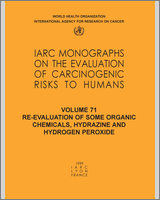NCBI Bookshelf. A service of the National Library of Medicine, National Institutes of Health.
IARC Working Group on the Evaluation of Carcinogenic Risks to Humans. Re-evaluation of Some Organic Chemicals, Hydrazine and Hydrogen Peroxide. Lyon (FR): International Agency for Research on Cancer; 1999. (IARC Monographs on the Evaluation of Carcinogenic Risks to Humans, No. 71.)
Data were last reviewed in IARC (1976) and the compound was classified in IARC Monographs Supplement 7 (1987).
1. Exposure Data
1.1. Chemical and physical data
1.1.1. Nomenclature
- Chem. Abstr. Serv. Reg. No.: 765-34-4
- Systematic name: Oxirane-carboxaldehyde
1.1.2. Structural and molecular formulae and relative molecular mass

1.1.3. Physical properties (for details, see IARC, 1976)
- (a) Boiling-point: 112–113°C
- (b) Conversion factor: mg/m3 = 2.95 × ppm
1.2. Production and use
Glycidaldehyde has been used as a cross-linking agent for the finishing of wool, for the oil tanning and fat liquoring of leather and surgical sutures (IARC, 1976).
2. Studies of Cancer in Humans
No data were available to the Working Group.
3. Studies of Cancer in Experimental Animals
Glycidaldehyde was tested for carcinogenicity in mice by skin application and by subcutaneous injection and in rats by subcutaneous injection. It produced malignant tumours at the site of application in both species (IARC, 1976).
4. Other Data Relevant to an Evaluation of Carcinogenicity and its Mechanisms
4.1. Absorption, distribution, metabolism and excretion
No data were available to the Working Group.
4.2. Toxic effects
4.2.1. Humans
Glycidaldehyde produces skin irritation and sensitization (IARC, 1976).
4.2.2. Experimental systems
Repeated inhalation of glycidaldehyde by rats resulted in a reduction in nucleated marrow cells and focal necrosis of liver and kidney. Repeated intravenous injections into rabbits lowered the leukocyte count and the proportion of polymorphonuclear cells. It is also irritating to the skin and mucous membranes (IARC, 1976). The carcinogenicity and genotoxicity of glycidaldehyde have been reviewed (Feron et al., 1991).
4.3. Reproductive and developmental effects
No data were available to the Working Group.
4.4. Genetic and related effects
The genotoxicity of glycidaldehyde has been reviewed (Feron et al., 1991).
4.4.1. Humans
No data were available to the Working Group.
4.4.2. Experimental systems (see Table 1 for references)
Table 1
Genetic and related effects of glycidaldehyde.
Glycidaldehyde induces mutations in bacteriophage T4, bacteria, yeast and sex-linked recessive lethal mutations in Drosophila melanogaster, but not hprt locus mutations in mouse lymphoma L5178Y. DNA adducts can be found in vitro using calf thymus DNA and in vivo in skin cells of mice treated topically with glycidaldehyde. The main adduct, in this case, has been identified as a cyclic adduct of deoxyadenosine, namely, 3-β-D-deoxyribofuranosyl-7-(hydroxymethyl)-3H-imidazo[2,1-i]purine-3′-monophosphate. The frequency of this adduct was 1 adduct per 6.4 × 104 nucleotides after a 2-mg application and 1 adduct per 7.6 × 103 nucleotides after a 10-mg skin-painting (Steiner et al., 1992). Glycidaldehyde gave a marginally positive result of uncertain significance for the morphological transformation of Syrian hamster embryo cells in vitro.
5. Evaluation
No epidemiological data relevant to the carcinogenicity of glycidaldehyde were available.
There is sufficient evidence in experimental animals for the carcinogenicity of glycidaldehyde.
Overall evaluation
Glycidaldehyde is possibly carcinogenic to humans (Group 2B).
6. References
- Corbett T.H., Heidelberger C., Dove W.F. Determination of the mutagenic activity to bacteriophage T4 of carcinogenic and noncarcinogenic compounds. Mol. Pharmacol. 1970;6:667–679. [PubMed: 5497717]
- Feron V.J., Til H.P., de Vrijer F., Woutersen R.A., Cassee F.R., van Bladeren P.J. Aldehydes: occurrence, carcinogenic potential, mechanism of action and risk assessment. Mutat. Res. 1991;259:363–385. [PubMed: 2017217]
- IARC (1976) IARC Monographs on the Evaluation of Carcinogenic Risk of Chemicals to Man, Vol. 11, Cadmium, Nickel, Some Epoxides, Miscellaneous Industrial Chemicals and General Considerations on Volatile Anaesthetics, Lyon, pp. 175–181. [PubMed: 992654]
- IARC (1987) IARC Monographs on the Evaluation of Carcinogenic Risks to Humans, Supplement 7, Overall Evaluations of Carcinogenicity: An Updating of IARC Monographs Volumes 1 to 42, Lyon, p. 64. [PubMed: 3482203]
- Izard C. Studies on the mutagenic effects of acrolein and two of its epoxides: the glycidol and the glycidal, on Saccharomyces cerevisiae. C. R. Acad. Sci. Paris. 1973;276:3037–3041. (in French) [PubMed: 4198809]
- Knaap A.G.A.C., Voogd C.E., Kramers P.G.N. Comparison of the mutagenic potency of 2-chloroethanol, 2-bromoethanol, 1,2-epoxybutane, epichlorohydrin and glycidaldehyde in Klebsiella pneumoniae, Drosophila melanogaster and L5178Y mouse lymphoma cells. Mutat. Res. 1982;101:199–208. [PubMed: 6806641]
- McCann J., Choi E., Yamasaki E., Ames B.N. Detection of carcinogens as mutagens in the Salmonella/microsome test. Assay of 300 chemicals. Proc. natl Acad. Sci. USA. 1975;72:5135–5139. [PMC free article: PMC388891] [PubMed: 1061098]
- Pienta R.J., Poiley J.A., Lebherz W. III. Morphological transformation of early passage golden Syrian hamster embryo cells derived from cryopreserved primary cultures as a reliable in vitro bioassay for identifying diverse carcinogens. Int. J. Cancer. 1977;19:642–655. [PubMed: 863543]
- Steiner S., Crane A.E., Watson W.P. Molecular dosimetry of DNA adducts in C3H mice treated with glycidaldehyde. Carcinogenesis. 1992;13:119–124. [PubMed: 1733564]
- Van Duuren B.L., Loewengart G. Reaction of DNA with glycidaldehyde. J. biol. Chem. 1977;252:5370–5371. [PubMed: 560373]
- Wade M.J., Moyer J.W., Hine C.H. Mutagenic action of a series of epoxides. Mutat. Res. 1979;66:367–371. [PubMed: 379632]
- Glycidaldehyde - Re-evaluation of Some Organic Chemicals, Hydrazine and Hydrogen...Glycidaldehyde - Re-evaluation of Some Organic Chemicals, Hydrazine and Hydrogen Peroxide
- PREAMBLE - Re-evaluation of Some Organic Chemicals, Hydrazine and Hydrogen Perox...PREAMBLE - Re-evaluation of Some Organic Chemicals, Hydrazine and Hydrogen Peroxide
Your browsing activity is empty.
Activity recording is turned off.
See more...
